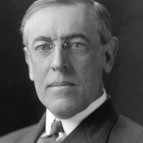
Woodrow Wilson (1856–1924) was the 28th President of the United States. Born in Virginia, he graduated from Princeton University (then the College of New Jersey) and the University of Virginia Law School before going on to earn his doctorate at Johns Hopkins University. A successful professor of political science, Wilson became the president of Princeton University in 1902. He successfully ran for governor of New Jersey in 1910, pursuing a progressive platform while in office. At the 1912 Democratic Convention, Wilson was nominated for president. During his first term, Wilson oversaw the passage of the Federal Reserve Act, antitrust legislation, and new labor laws, including one that prohibited child labor. Entering his second term, Wilson realized that the US could no longer remain neutral in World War I. On April 2, 1917, he went before Congress to ask for a declaration of war on Germany. America’s entry into the war gave the Allies the advantage, bringing the war to an end. After the 1918 Armistice, Wilson encouraged the US to sign the Treaty of Versailles and join the League of Nations, but the treaty failed in the Senate by seven votes.
Woodrow Wilson
President Woodrow Wilson (1856–1924) gave two major speeches about Flag Day and the American flag. Although delivered only one year apart, they differed greatly in tone and content. On June 14, 1915, in the first of these speeches, Wilson addressed a crowd—including members of his Cabinet—in front of the Treasury Department, at a ceremony paying tribute to the flag.
Woodrow Wilson
In this address on June 14, 1916, two weeks after his presidential proclamation regarding Flag Day, President Woodrow Wilson (1856–1924) celebrated the first national Flag Day at a ceremony held near the Washington Monument.
Woodrow Wilson
If the Civil War was the defining national experience of the 19th century, the two World Wars were arguably the defining American experiences of the 20th century. A disappointed but determined President Woodrow Wilson (1856–1924) gave this (excerpted) speech before the US Congress on April 2, 1917, asking for a declaration of war on Germany.
Woodrow Wilson
Less than a year after his speech about the flag as an emblem that reflects back our national history and experience, President Woodrow Wilson (1856–1924) was thinking differently about the importance of the flag.
Woodrow Wilson
At different times in our nation’s history, our national leaders have used the occasion of Independence Day to revisit the Declaration of Independence and to comment on its significance, often attempting to interpret its meaning in the light of contemporary circumstances. This Independence Day speech by President Woodrow Wilson (1856–1924), delivered at Philadelphia’s Independence Hall on July 4, 1914 (six days after the assassination of Austrian Archduke Franz Ferdinand, the trigger for World War I), is a particularly striking example of this practice.

